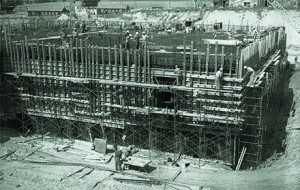
Radio, television, the newspapers and most of social media were all buzzing, Monday night, because Toronto Police had found a tunnel a stone’s throw from an indoor tennis court facility in northwest Toronto. It wasn’t just any tennis court. It wasn’t just any tunnel. The tunnel was big enough to live in and apparently pointed in the direction of the Toronto Pan-American Games tennis venue – the Rexall Centre. But when asked at a press conference if he thought the tunnel was part of a terrorist plot, Deputy Chief Mark Saunders had a simple response:
“There’s no criminal offence for digging a hole,” he said.
In case you missed it, Toronto Police Services explained at a Tuesday media briefing that, about a month ago, a parks worker walking through the snowy woods near York University tripped over a sheet of metal. Beneath the metal, the police said, he found an entrance to a vertical shaft down, which led to a 10-metre-long horizontal tunnel, big enough for a person of average height (about six feet tall) to stand in or walk through. Inside the mysterious tunnel reinforced with relatively fresh lumber, police told reporters, they also found a generator and sound baffles, a compressor for tools, a sum pump, water-resistant light bulbs, a pulley system, wheelbarrow and other tools, and food and drink containers.

“At this time, we’re unable to determine who constructed this chamber,” Saunders said, “nor can we determine what the motive was for building it.”
Despite police emphasizing they had no reason to believe the designer(s) and builder(s) of the chamber had ill intent, word of the tunnel near an international sporting venue got imaginations soaring, tongues wagging and paranoia rising. Typical of that sentiment was the reaction of security expert Ray Boisvert, heard on CBC Radio.
“Nobody would build something like that,” he said, “without a specific purpose.”
Whoa! Hold on conspiracy lovers! Lest the country flip into a frenzy, go off the deep end or descend into a weapons-of-mass-destruction state-of-mind here, let me offer a couple of thoughts that perhaps the police, the public and yes, all the anti-terrorism security experts may have overlooked. Can’t any of them remember what life as a kid in the country, or at least what venturing forth into the country, was like? Don’t they recall one’s first instincts given a large climbable tree, an accessible riverbank or, yes, a sandy cliff side? Of course, no self-respecting boy or girl would dare pass up such an opportunity without considering it the perfect location for a fort!
Or, advance the clock from a summer landscape to a winter one, not unlike some of the conditions we’ve experienced around southern Ontario in recent weeks. Put a kid outside near a snowdrift, and I dare you to keep him or her from instantly turning into a human weasel burrowing into the snow to create a hollowed out cave or more dangerously an elongated chamber or tunnel to nowhere. Then, depending on whether the tree fort, cliff-side cave or snow tunnel survived until the next visit, the occupant would usually install such amenities as walls, seats and even utensils – all the comforts of home, as it were. And why? Well, because they could!
And if you’re prepared to imagine all of that for a second, let me roll out one additional thought. I’m old enough to remember the hysteria of the 1950s, when a lot of children and adults thought Kennedy or Khrushchev – especially at the time of the Cuban missile crisis – were about to blow us all to kingdom come in all-out thermo-nuclear war. Many of us felt as if global annihilation was just a Kremlin or Pentagon button press away.

Meanwhile, others took matters into their own hands and – like their ancestors in the 1940 Blitz – decided to build bomb shelters underground with enough supplies to last until the Cold War fallout passed. Perhaps the most famous shelter was the four-story, 300-room, 100,000-square-foot underground chamber near Ottawa and designed to house over 500 Canadian government officials if worse came to worst.
“Shrouded in mystery,” the modern day museum website points out, “the Diefenbunker, nicknamed after then Prime Minister John Diefenbaker, was designed and built in secrecy during the crest of Cold War fear, between 1959 and 1961.”

And here’s my theory. Sixty years ago, when the nuclear scare ran wild, some practically minded Torontonian with access to a country field miles from downtown, decided to build his own Diefenbunker … just in case. Years later, when the Cold War was just a faint memory, an enterprising group of youngsters stumbled on the 1950s holocaust hollow and made it over into hideaway. They added a compressor, a sum pump and all the comforts of home.
Voila! A 21st century adolescent fort.
Hey Ted, an amusing theory. With all the Harper terrorist law thinking, everybody is thinking some devious reason for it. When it might, as you say, be some kids stumbling on a tunnel, and fortifying it.
Thanks for the reply, Geoff. I thought the Toronto Police Services response to the discovery was measured, calm and quite informative. Saunders’ press conference offered details of the discovery and sought help from anyone with information. In contrast to the ramped-up paranoia around the terrorism bill, it was quite level-headed, I thought. Best… Ted.